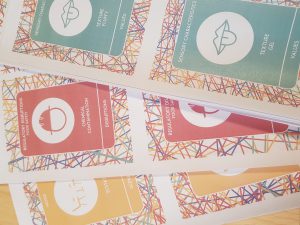
October 9, 2019, by Hazel Sayers
Food design for future dining (FD2)
Food in the digital era is radically transforming. The supply chain is reshaping, with distribution networks evolving and on-line retailers providing a significant and ever-growing part of the market. At the same time, consumers spend longer online, impacting their food preferences and consumption practices. How we leverage digital technology to deliver next generation food systems capable of delivering sustainable, healthy and safe foods remains an open question. A significant part of the work in using digital technologies around foods is currently focusing on smart precision-agriculture. But less well explored is the significant potential digital technologies have to radically reconfigure food supply chains, and the way consumers interact with foods.
Food Design for Future Dinging, or FD2, is exploring how digital technologies can be used to enhance the food consumption experience, by demonstrating prototypical hybrid foods – food stuffs that are created to provide a novel physical and digital eating experience, and that are enhanced by the inclusion of relevant provenance information. As we unpack the design space, we’re seeing that there is great potential, and complexity, in how food and data speak to a wide range of consumer values.
The core team brings together expertise in Mixed Reality and Human-Computer Interaction from Computer Science (Martin Flintham, Dimitri Darzentas, Emily Thorn), Food Process Engineering from Engineering (Serafim Bakalis), and Food Legislation and Compliance from Law (Richard Hyde). We’re also working with Blanch and Shock, a London based catering and design SME who are delivering cutting-edge culinary expertise.
We have four activities underway, broadly aligned with different elements of food consumption with the consumer in mind.

Enhancing the consumer experience with digital footprints. The French app https://yuka.io/en/ is making waves by using data to alert consumers as to whether products are good or should be avoided. Our first demonstrator is a digitally augmented cake gift, that uses augmented reality to provide two kinds of provenance to enhance the cake consumption experience. Functional or utilitarian information such as nutritional or allergen data, or what we might think of as hard provenance is, as with Yuka, presented by an app. We are also exploring soft provenance; rich narrative data such as stories about ingredients, how the cake was made and decorated and by whom, that speak to a broader set of values. Moving forward we’ve got our sights set on chocolate.
Enhancing product development. We’re building on some work we began with Qian Yang in UoN Sensory Sciences, which is looking to enhance the validity of consumer testing methodologies in the lab. By increasing the contextual validity of a lab study, we can reduce the failure rate of new products. Here we turn again to new immersive technologies to change the consumption experience but also allow naturalistic food consumption. Using Augmented Virtuality we’re taking consumer panels out of the lab into a variety of virtual environments to see how they can improve validity, or ultimately provide a radical new dining experience.

Enhancing food-as-a-service. Here we’re considering how food can be manufactured to be more relevant, more personalised or more value sensitive in the first place. We’ve finished designing a set of food development ideation cards that articulate not just flavour and physical properties, but also values, scenarios and contexts. The concepts that they embody are forming the basis for a technology probe into customised meal preparation, combined with a variety of non-soy miso recipes created by Blanch and Shock.
We are building a community of UoN academics in the broad area of “Smart Foods” and identifying key external partners to collaborate with. We will utilise existing UoN investment, e.g. through the Beacons to create a critical mass that would enhance collaboration and enable us to respond to future funding opportunities. In the immediate term the team presented a poster at the Connected Everything conference in June, and have also been demoing the work to various industry partners. In September, Serafim Bakalis spoke at ICEF 13, the International Congress of Food Engineering, making the proposition for a consumer focus on digital in the food domain.
No comments yet, fill out a comment to be the first

Leave a Reply